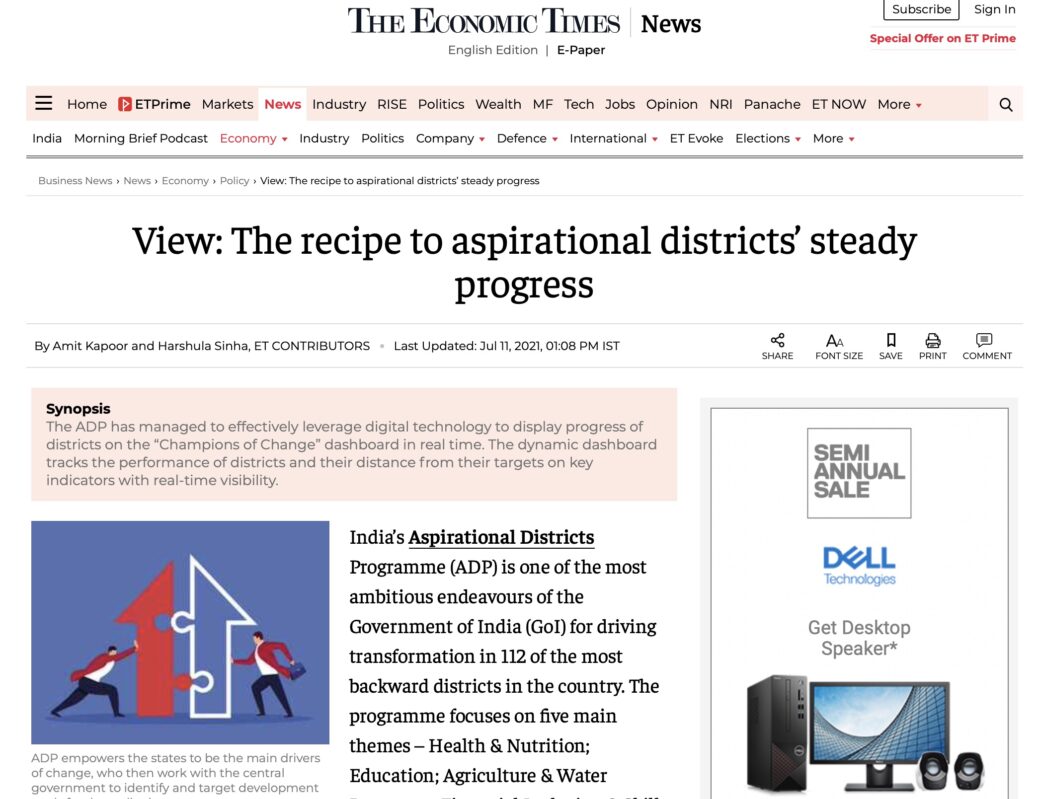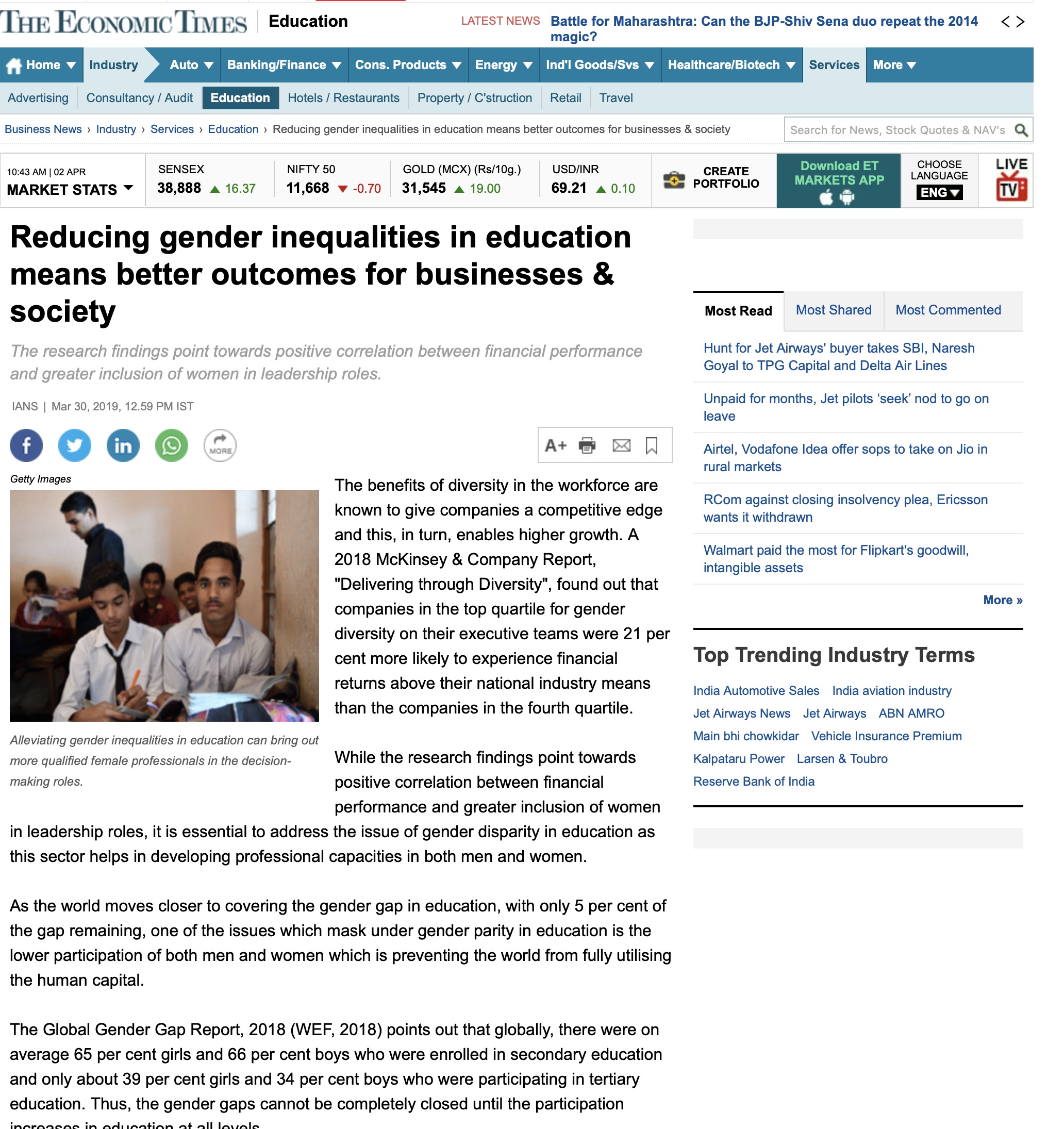The recipe to aspirational districts’ steady progress
India’s Aspirational Districts Programme (ADP) is one of the most ambitious endeavours of the Government of India (GoI) for driving transformation in 112 of the most backward districts in the country. The programme focuses on five main themes – Health & Nutrition; Education; Agriculture & Water Resources; Financial Inclusion & Skill Development; and Basic Infrastructure. Since the launch of ADP in 2018, the aspirational districts have made immense progress. Recently, a UNDP appraisal report titled Aspirational Districts Programme: An Appraisal recognized that the programme resulted in sectoral growth and improvements in governance and administration and commends it for applying “innovative techniques”. The question is, “What are these innovative techniques that sets ADP apart from other similar developmental initiative?”
Cooperative and competitive federalism
Cooperative federalism implies States and Centre cooperating with each other to realise the developmental goals of the country. It calls for a joint focus on the national development goals by the Centre and States, and the advocacy of concerns and issues of States and Union Territories with Central Ministries. The idea of competitive federalism, on the other hand, promotes competition between Centre and States as well as among States for economic benefits. In cooperative federalism, the relationship between States and Centre is horizontal, and in competitive federalism, it is vertical between States and Centre and horizontal among states.
As a pan-India initiative that aligns the efforts of Union and state governments, the ADP espouses cooperative federalism. It empowers the states to be the main drivers of change, who then work with the central government to identify and target development goals for these districts. The programme also imbibes the spirit of competitive federalism by promoting positive competition among states to push them to work towards realizing common goals. Competitive federalism not only aims for states to compete but also learn from each other and enable more developed regions to partner with the least developed regions to help them transform, which contributes to the idea of cooperative federalism. Thus, the combination of cooperative and competitive federalism has become the fuel driving transformation in aspirational districts.
The 3C approach
In adherence to the spirit of cooperative and competitive federalism, the ADP adopts a multi-pronged approach, called the 3C approach, which forms the core principles of the program. The 3Cs are interconnected and stand for the following: –
- Convergence(of Central and State schemes): The principle of convergence harks back to the idea of cooperative federalism, wherein state governments and the Union government converge their efforts towards common goals. Convergence is imperative for the success of the programme as the concurrent powers of the states and Centre risk leading to overlap of policies, duplication of efforts and a tussle over jurisdiction and resources, especially in the case of more prosperous and developed states who are adequately equipped to implement their own schemes and programmes.
India’s quasi-federal structure has often drawn scrutiny over the imbalance of power that favours the Centre, but the spatial disparities across states also call for greater support to the less developed states. The ADP takes the middle path of converging the efforts of states and the Centre, with state governments being the main drivers of change, which eliminates the issue of overlapping efforts as well as allows the historically backward states to take a more proactive role in development.
- Collaboration(among citizens and functionaries of Central & State Governments including district teams): The principle of convergence necessitates seamless collaboration between the civil society and the functionaries of the state and central government. In order to create policy convergence, the programme mandates nomination of a Central Prabhari Officer of the rank of Additional Secretary/ Joint Secretary for each district and a similar State Prabhari Officer at the level of the State Government. This facilitates collaboration at all levels of the government, whereby greater decentralisation is achieved, which allows ground realities to inform strategies and enables local experimentation tailored to the needs of each district. In this way, local government institutions work in collaboration with the Central and State government to usher transformation.
The programme also encourages collaborations with international development organisations and civil society. Unlike traditional partner engagement approaches, the ADP integrates the external development partners within the state institutions. The partners, therefore, work within rather than outside the institutional apparatus of the government. They are involved in improving the quality of governance at the grassroots, augmenting the capacity of the district administration to deliver citizen services as well as ensuring performance management and accountability through their data validation efforts. Thus, the seamless collaboration incorporated in ADP’s structure subverts the tradition of working in silos
- Competition(among districts): The monitoring dashboard and the monthly ranking system is leveraged by the ADP to drive competition between the aspirational districts. When the districts are able to track their progress and compare their performance with their peers, they are incentivised to to improve their efforts to climb up higher in the rankings. There are two types of rankings published by NITI Aayog- Delta ranking captures change in district ranking over time and baseline ranking captures the district performance compared to the baseline year. This helps districts keep sight of their goals and progress both in relative and absolute terms.
Real-time monitoring
The ADP has managed to effectively leverage digital technology to display progress of districts on the “Champions of Change” dashboard in real time. The dynamic dashboard tracks the performance of districts and their distance from their targets on key indicators with real-time visibility. The dashboard also presents the annual scores for the best performing district within a particular state for each indicator. All these functions of the dashboard work to strengthen competition. Moreover, the availability of dashboard in the public domain improves transparency and accountability, which encourages citizen participation in the governance process.
Thus, the ADP breaks away from the status quo in a number of ways. The institutional structure and innovative practices deployed by the programme recognise the issues of conventional approaches and forges a new path that is cognizant of ground realities. The programme encapsulates a strong set of innovative practices that can evolve based on the learnings along the way, as well as inspire similar approaches in other developmental schemes.
The article was published with Economic Times on July 11, 2021.
























